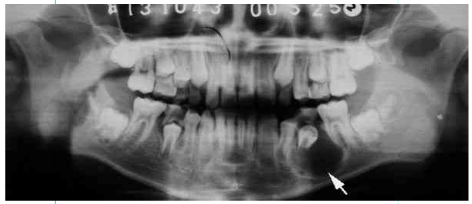Eruption cyst
OVERVIEW
What is an eruption cyst?
An eruption cyst occurs in the mucosal soft tissue covering the crown of an erupting deciduous or permanent tooth. It is a dentigerous cyst that forms outside the bone in soft tissue, resulting from fluid accumulation between the reduced enamel epithelium and the enamel of the erupting tooth.
Are eruption cysts common?
Yes.
They primarily occur in children, occasionally in adults, and are more common in males than females.
Are eruption cysts and dentigerous cysts the same condition?
Not exactly.
A dentigerous cyst, also called a follicular cyst, refers to a cyst whose wall encloses the crown of an unerupted tooth and attaches to the tooth's neck. Dentigerous cysts develop within the jawbone, whereas eruption cysts are dentigerous cysts that occur in the soft tissue outside the jawbone. They are cysts located in different areas.
SYMPTOMS
What are the common manifestations of eruption cysts?
Eruption cysts are localized lesions during the eruption of deciduous and permanent teeth:
-
They often appear on the mucosal surface of the erupting tooth as a blue, translucent, elastic, round soft tissue mass.
-
The most common site of occurrence is the mandibular third molar area, followed by the canine and premolar regions.
-
The cyst grows slowly, with no noticeable symptoms in the early stages, and often occurs as single or multiple lesions, unilaterally or bilaterally.
What other conditions can eruption cysts cause?
When tooth eruption is significantly delayed, it can lead to complications such as pulp necrosis, temporomandibular joint ankylosis, and damage to the periodontal ligament and gingiva of adjacent teeth. It may also prolong orthodontic treatment and affect therapeutic outcomes.
CAUSES
What are the causes of eruption cysts?
There are several theories regarding the origin of eruption cysts, such as:
-
They may result from early dental caries, trauma, infection, lack of eruption space, or genetic predisposition. However, the exact etiology of eruption cysts remains unclear. Some reports suggest that taking cyclosporine can induce eruption cysts.
-
Pathologically, eruption cysts originate from the reduced enamel epithelium formed during enamel development or from the remnants of the dental lamina covering the erupting tooth. They are located on the crown surface of the erupting tooth and consist of non-keratinized squamous epithelium. Eruption cysts have no pathological specificity and often do not require pathological confirmation. Radiographically, eruption cysts appear as an enlarged dental follicle space, forming a clear crescent-shaped radiolucent area surrounding the tooth.

DIAGNOSIS
What is the diagnostic basis for eruption cysts?
Doctors generally diagnose it based on medical history, oral examination, and panoramic radiographs after ruling out other diseases.
What tests do patients with eruption cysts need? Why are these tests performed?
The diagnosis of eruption cysts mainly relies on characteristic clinical symptoms and X-rays, so oral examinations and X-ray imaging are required to diagnose the condition, assess prognosis, and exclude other diseases.
What conditions need to be differentiated from eruption cysts?
Eruption cysts need to be distinguished from hemangiomas, neonatal alveolar lymphangiomas, pyogenic granulomas, and mercury lines.
TREATMENT
Which department should I visit for an eruption cyst?
Oral surgery, dentistry.
Does an eruption cyst require hospitalization?
Usually not.
How is an eruption cyst typically treated?
In most cases, eruption cysts resolve spontaneously, so the recommended treatment is close monitoring and follow-up during the eruption of the affected tooth.
If the cyst does not resolve during follow-up and surgical intervention is deemed necessary, oral hygiene instructions should first be provided. If infection is present, antibiotics or other antimicrobial agents must be used to control inflammation before surgery. Preoperative X-rays should be taken to determine the extent of the cyst and its relationship to adjacent tissues. Typically, the surgical procedure for an eruption cyst is straightforward, involving removal of the affected soft tissue and exposure of the crown.
DIET & LIFESTYLE
What should eruption cyst patients pay attention to in their diet?
Consume more vitamin-rich foods and minimize spicy or irritating foods.
What should eruption cyst patients pay attention to in daily life?
Although tooth eruption usually does not cause severe pain or significant discomfort, the appearance of an eruption cyst can be a stressful experience.
When parents notice abnormalities during tooth eruption, especially the unusual color of an eruption cyst, it may trigger panic, as the large bluish-purple or bluish-black lesion might be mistaken for a malignant tumor. Therefore, parents and patients should clearly understand that this is a benign condition to alleviate unnecessary fear.
Do eruption cysts require follow-up? How is follow-up conducted?
Early detection of eruption cysts requires close monitoring and follow-up, primarily to observe whether they resolve spontaneously as the tooth erupts. After surgery, specific follow-up is usually unnecessary, and routine dental check-ups are sufficient.
PREVENTION
Can eruption cysts be prevented?
Since the cause of eruption cysts is not clear, a healthy diet and lifestyle combined with regular oral examinations for early detection are the best ways to prevent them.
How can patients with eruption cysts prevent complications?
Complications of eruption cysts usually occur when the cyst does not resolve on its own and continues to grow, leading to lesions in adjacent soft tissues and affected teeth. Therefore, timely surgical treatment when the cyst fails to resolve naturally can prevent complications.